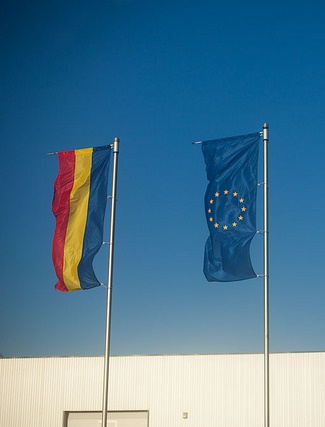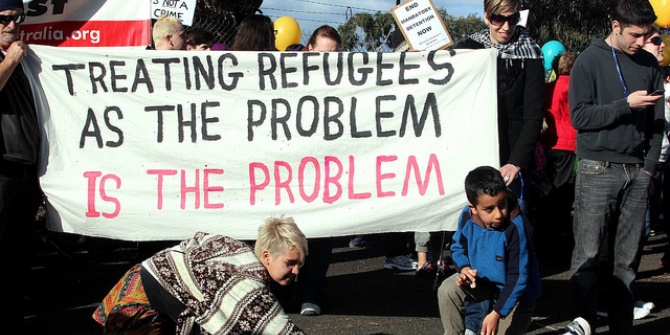 Stigmatisation can sometimes strengthen ethnic solidarity or identification amongst migrants. Laura Morosanu explores how Romanian migrants in Britain have responded to stigmatisation. She finds that although there are attempts to redefine ethnicity to transfer the stigma away from individuals, many responses do not draw on ethnicity at all.
Stigmatisation can sometimes strengthen ethnic solidarity or identification amongst migrants. Laura Morosanu explores how Romanian migrants in Britain have responded to stigmatisation. She finds that although there are attempts to redefine ethnicity to transfer the stigma away from individuals, many responses do not draw on ethnicity at all.
Migrants are often portrayed as associating with co-ethnics, emphasising ethnic belonging, or drawing on other ethnic resources in coping with their everyday life and predicaments. Whilst ethnicity may provide benefits, comfort or protection, it can also be a basis for stigmatisation. What happens when negative attributes are repeatedly attached to particular migrant groups? How do migrants cope with stigmatised identities and how does ethnicity inform the strategies they develop? These are the questions Jon Fox and I examined, based on our research projects with Romanians in Britain. Although stigmatisation was not the main focus of our studies, we uncovered plenty of evidence of it in the data we collected.

Stigmatisation can sometimes strengthen ethnic solidarity or identification amongst migrants. But it can also have the opposite effect, generating ambivalence and efforts to take distance from the stigmatised ethnicity. Our interest was in how, if at all, ethnicity achieves relevance in the strategies ordinary Romanian migrants devised to cope with stigmatisation. By exploring this question, we aimed to contribute to efforts to challenge the privileged role ethnicity often holds in accounts of migrants’ experiences, yet without ignoring it altogether. In other words, we remained sensitive to how migrants themselves could reinvest ethnicity with salience. The two main strategies for coping with stigma we identified both emphasised ethnicity, although in a negative way, and deflected its relevance.
Romanians’ migration has not been viewed favourably in their destination countries. Across Europe, Romanians have often been received with scorn and associated in public discourse with crime, begging, and damaging outcomes. Romania’s accession to the European Union in 2007 has only amplified fears in the West about future migration from one of the poorest member states. This has not excluded Britain, which had already received higher than expected numbers of East European migrants after 2004, and regards further migration from Bulgaria and Romania with mounting anxiety. The British tabloid press has thus repeatedly targeted Romanians before and after their accession to the EU, reinforcing the wealth of negative stereotypes circulating in the rest of Europe. Stories of ‘invasion’, crime, and strain on services have come to define these new European migrants to Britain.
Many Romanians we spoke to agreed that Romanians bear a ‘negative stamp’ abroad. This awareness, however, did not necessarily encourage them to refashion a collective ethnic identity in positive ways. As in other cases of stigmatised migrants, some internalised and reinforced the widely circulated stereotypes about Romanians in a way that conveyed embarrassment, and sometimes the view that ‘there’s no smoke without fire’. Nevertheless, most did not remain passive victims of stigmatisation, and developed alternative strategies to recover their individual (if not collective) self-esteem.
One strategy to cope with Romanians’ ‘spoiled’ image did emphasise ethnicity, but in a negative way. In an effort to dissociate themselves from the stigmatised, some of our participants sought to transfer the stigma to the Roma with whom Romanians are often associated. Blaming the Roma for Romanians’ tarnished image abroad has been documented. Romania is one of the East European countries with a large Roma minority who has long suffered from acute socio-economic marginalisation and discrimination. Western states have not necessarily been more welcoming towards them. The hostile reception of Roma migrants across Europe and recent expulsion campaigns from France and Italy powerfully illustrate their ‘unwanted’ status. Against this backdrop, repeated conflations between Roma and Romanians in Western Europe have stirred discomfort, as various studies show, in Romanian politics and press about their ‘damaging’ effect on Romanians’ reputation abroad.
Romanians who moved abroad often experienced first-hand conflations with the Roma in their destination countries. Some were labelled Roma; others faced negative commentary about the Roma when asked about their background. One strategy to respond to such conflations thus sought to ‘correct’ this view by informing locals about the difference between Romanians and Roma. This rhetoric of differentiation focused particularly on numbers, calling attention to the numerical minority of the Roma and thus ‘limited’ representativeness for Romanians as a whole. Cultural differences and practices were also invoked in attempts to justify what earned them, and by extension Romanians, a notorious reputation across Europe. Furthermore, racialised markers sometimes served to establish the difference between Roma and Romanians. In such cases, colour became the most straightforward way to signal to outsiders the difference between ethnic Roma and Romanians.
Intentionally or not, the boundaries between Romanians and Roma have been blurred, and some migrants’ response to this was to the redraw them, by highlighting the difference between ethnic Roma and Romanians. In attempting to reassert their status, those resorting to this rhetorical strategy did so at the expense of the Roma. Ethnicity thus achieved renewed relevance in the process. This strategy was not favoured by some migrants; workers, students or professionals could equally employ it in their endeavour to challenge what locals perceived as a single migrant group.
But awareness of stigmatisation did not always generate responses that brought ethnicity centre stage. Another way to cope with negative discourses about Romanians was to call attention to individual skills and work ethic. Such qualities enabled migrants to build successful careers or ‘fit in’ despite Romanians’ negative image abroad. If the first strategy sharpened ethnic boundaries and divisions, individual stories of adaptation and professional accomplishment diminished their importance.
Taking distance from media representations, various professionals we spoke to saw ethnicity as irrelevant in their career trajectories. Their skills and qualifications mattered most, cementing their reputation amongst work colleagues, and compensating for, or even excluding the possibility of stigmatisation in their daily life. Education also enabled migrants who possessed university degrees but worked in lower-skilled occupations to build and assert status, moving away and above the unhappy fate of Romanians as a whole. Whilst directing their grievance towards work restrictions (lifted in 2014), many emphasised how their upbringing, qualifications, and work ethic allowed them to ‘get on well’ with colleagues, clients, and employers, and sometimes befriend some of them.
This strategy to manage stigmatisation was not reserved for highly educated migrants. Participants from less advantaged socio-economic backgrounds could also refer to work ethic and professionalism, depicting their success in light of a perceived meritocratic system prevailing in Britain. Being talented, ‘hard-working’, and ready to do ‘something extra’ could open up opportunities for career progression. What is more, such qualities enabled some migrants to ‘keep [their] head up’ in the face of stereotypes, and focus on building successful lives and careers abroad. Such attempts to elevate status rendered ethnicity less relevant in everyday interactions with locals.
Our analysis thus revealed that responses to stigmatisation both emphasise and weaken the role of ethnicity in migrants’ experience. Attempts to transfer the stigma and its roots onto the Roma with whom Romanians are frequently associated redrew, and thus reinforced, ethnic boundaries. Highlighting individual skills and achievements as a way to escape stigmatisation had the opposite effect, obscuring ethnic divisions. These coping tools could be alternatively employed by the same migrants, showing that ethnicity has fluctuating, rather than declining relevance, in individuals’ discourses and practices. Migrants’ efforts to establish their status worked to reinforce, rearrange, or at times remove ethnic boundaries.
Note: This article gives the views of the author, and not the position of the British Politics and Policy blog, nor of the London School of Economics. Please read our comments policy before posting.
About the Author
 Laura Morosanu is a lecturer in Sociology in the School of Law, Politics and Sociology at the University of Sussex. Her main research interests are in the areas of migration and ethnicity, with a focus on migrants’ local and transnational social relationships.
Laura Morosanu is a lecturer in Sociology in the School of Law, Politics and Sociology at the University of Sussex. Her main research interests are in the areas of migration and ethnicity, with a focus on migrants’ local and transnational social relationships.







